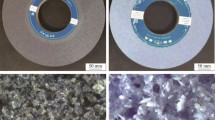Abstract
This paper presents experimental research on nickel-based alloy grinding using superabrasive wheels and Al2O3 wheels. Through on-line monitoring and off-line inspection, grinding performance and cost are studied based on statistical analysis. By using multi-objective optimization, the models of performance and cost assessment are built to evaluate the grinding performance and cost under different grinding conditions. In this way, the grinding performance and cost of different wheels can be quantitatively and qualitatively compared. With a comprehensive performance-cost analysis, the performance index of diamond wheels have been testified to be considerably higher than that of Al2O3 wheels even though their purchase cost is much higher than that of Al2O3 wheels.
Similar content being viewed by others
References
Knowles DM, Chen QZ (2003) Superlattice stacking fault formation and twinning during creep in γ/γ′ single crystal superalloy CMSX-4. Mater Sci Eng A 340(1):88–102
Hitchiner M (1999) Grinding of aerospace alloys with vitrified CBN. Abrasives magazine (Dec 1998/Jan 1999) pp 25–32
Comley P, Stephenson DJ et al (2004) High-efficiency deep grinding and the effect on surface integrity. Key Eng Mater 257–258:207–212
Stephenson DJ, Jin T et al (2002) High-efficiency deep grinding of a low alloy steel with plated CBN wheels. CIRP Ann Manuf Technol 51(1):241–244
Xun Chen (2002) Systematic consideration of grinding process monitoring. Proceedings of the 8th Chinese Automation & Computer Science Conference in the UK, Sept. 2002, pp 175–178
Mohammed A, Elsharkawy A (2000) Effect of grinding forces on the vibration of grinding machine spindle system. Int J Mach Tools Manuf 40(14):2003–2030(28)
Jin T, Stephenson DJ (2003) Investigation of the heat partitioning in high efficiency deep grinding. Int J Mach Tools Manuf 43(11):1129–1134
Brinksmeier E, Heinzel C, Wittmann M (1999) Friction, cooling and lubrication in grinding. Ann CIRP 48(2):581–597
Shore P, Billing O et al (2004) A standard grinding wheel assessment method to support a sophisticated grinding knowledge based system. Key Eng Mater 257–258:285–290
Rowe BW, Yan Li, Chen XB (1997) Mills, an intelligent multiagent approach for selection of grinding conditions. Ann CIRP 46(1):233–238
Saravanan R, Sachithanandam M (2001) Genetic algorithm (GA) for multivariable surface grinding process optimization using a multi-objective function model. Int J Adv Manuf Technol 17(5):330–338
Kalpakjian S, Schmid SR (2001) Manufacturing engineering and technology, 4th edn. Prentice Hall International, London
Demetriou MD, Lavine AS (2000) Thermal aspects of grinding: the case of up-grinding. Trans ASME-J Manuf Sci Eng 122(4):605–611
Gardinier CF (1988) Physical properties of superabrasives. Ceramic Bull 67(6):1006–1009
Rowe WB (2001) Temperature case studies in grinding including an inclined heat source model. Proc Inst Mech Eng B J Eng Manuf 215(4):473–491
Morgan MN, Rowe WB et al (1998) Effective thermal properties of grinding wheels and grains. Proc Inst Mech Eng B J Eng Manuf 212(8):661–669
Holz R, Sauren J (1988) Grinding handbook: grinding with diamond and CBN. Ernst Winter and Sohn (GmbH & Co), Hamburg
Acknowledgements
The authors would like to express their thanks to the Rolls-Royce plc for their supports.
Author information
Authors and Affiliations
Corresponding author
Rights and permissions
About this article
Cite this article
Liu, Q., Chen, X. & Gindy, N. Assessment of Al2O3 and superabrasive wheels in nickel-based alloy grinding. Int J Adv Manuf Technol 33, 940–951 (2007). https://doi.org/10.1007/s00170-006-0519-1
Received:
Accepted:
Published:
Issue Date:
DOI: https://doi.org/10.1007/s00170-006-0519-1




